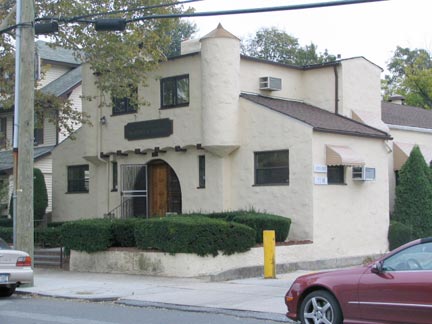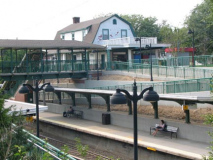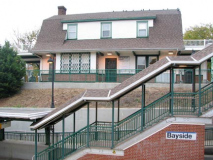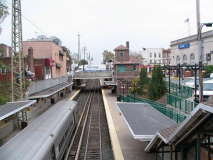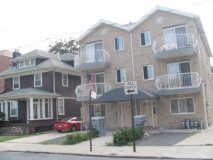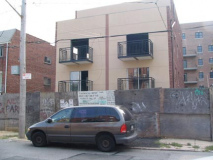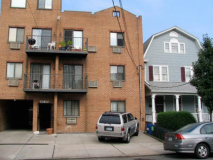My relationship with Bayside, Queens has been an ambivalent one: I have worked here (albeit anywhere from one to three days a week, at the Bayside Times newspaper chain) since 1996, yet I’ve always resisted it as far as Forgotten New York is concerned since it all seemed rather…boring, but in a beautiful way; it is one of Queens’ exclusive areas, and I’m reluctant to attend affairs where I do not necessarily fit in. To put a spin on a witticism by Groucho, I never hang around clubs where I wouldn’t be invited. Yet I persevere.
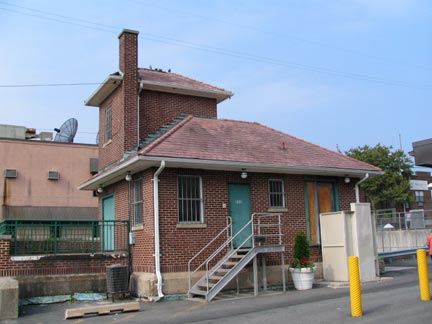
One of the LIRR’s “Easter eggs” at Bayside is the continued presence of a freight building, long unused since the LIRR ceased to be a freight carrier long ago.
Goods were unloaded on the platform and onto an elevator within the building and unloaded on 41st Road.
By the mid-1990s the station was really showing its age but it was at about that time that the LIRR began a lengthy process of renovation along the Port Washington Branch, with Murray Hill, Bayside, Auburndale, and finally Broadway (where construction is due to finish in 2008) all practically rebuilt. The main addition at Bayside was handicapped-accessible ramps on each side and replacement of the pedestrian track crossway, which, until it was replaced, was one of the few wooden covered bridges (albeit with a metal-framed concrete floor) you’d find in NYC.
The Bayside Long Island Rail Road station, from which commuters can get to Manhattan in about half an hour, has always been one of the more attractive on the Port Washington branch. A railroad has run here since 1866, when the Flushing and North Side Railroad, operated by Elizur Hinsdale, ran east through Bayside to Great Neck (Port Washington wasn’t reached till 1896). It became a part of the LIRR, then owned by rubber magnate Conrad Poppenhusen, in 1876. The present gambrel-roofed station (41st Avenue and 213th Street) dates to 1923, and the tracks themselves were placed in an open cut in 1927; till then, they ran across Bell Boulevard via a gate crossing.
Unlucky 213
In a neighborhood that otherwise features showcase-quality dwellings, 213th Street between the railroad cut at 42nd Avenue and Northern Boulevard has become a bastion of Barbara Corcoran-recommended, concrete-drivewayed, Fedderized Brave New World architecture of the early 21st Century.
Your webmaster is happy to be claimed by the 20th.
Roger, Ahles
After a bit of ginger ale to settle the ForgottenBelly, I ventured north of the railroad cut on 213th Street and located one of Bayside’s hidden treasures…
…where, on the west side just south of 39th Avenue, we find the venerable fish-scale mansard roofed John William Ahles House (built in 1873).
According to longtime Bayside historian Joan Brown Wettingfeld:
In 1873, Robert Bell, nephew of Abraham Bell [see below], built this house for his daughter, Lillie and her husband, John Ayles as a wedding gift on “Ahles Road” (now known as 41st Avenue). This road ran then from 208th Street to present day Bell Boulevard. Old maps show a portion of 41st Avenue as Ahles Road as late as 1941.
The naming of Ahles Road was no accident for the road supervisor at the time was Abraham Bell II, and John William Ahles married Robert Bell’s daughter, Lillie, in June of 1873.
Known for his integrity and business acumen, John William Ahles died in 1915 after amassing a large fortune.
The old Bayside Theatre on the NE corner of Bell Boulevard and 39th Avenue opened in 1927 (as the Capitol Theatre) and was designed by prolific theatre house architect Thomas Lamb. According to cinematreasures commenters, it was closed during much of the Depression, but reopened in 1941:
On November 7, 1941, it had a gala re-opening as the Skouras Bayside. Here’s a report from the Bayside Times: “Stars of stage, screen and radio attended the gala opening of the new Skouras Bayside Theatre, 38-39 Bell Boulevard. Among those who participated were Patti Pickens and Bob Simmons of radio and stage fame; Bob Douglas, NBC’s new singing star; Erik Rhodes, film comedian featured in many Ginger Rogers-Fred Astaire pictures, and others…The theatre has been completely rebuilt and decorated, with only the walls of the old structure retained. The lobby, auditorium and lounges have been furnished in keeping with present-day standards to create the most modern theatre on the North Shore…The new theatre will have complete changes of program twice each week, with special selected programs for children at 10 o’clock every Saturday morning.”
United Artists closed the theatre, which had deteriorated greatly from lack of maintenance, after the wekend of October 14, 2001; Zoolander was the final first-biled feature, along with Rush Hour 2 and a couple other unmemorable productions. The ground floor is now occupied by a Washington Mutual bank.
An aside: I remember as a freshman in college in 1975 a classmate named Marie Malluk interviewed Erik Rhodes for the school paper, the St. Francis College Voice, and it might have possibly been the most in-depth interview of the actor who usually was the foil or second banana during the 1930s golden cinematic era. This was long before the internet age, and I’m not sure I still have that issue.
A stroll east from Bell Blvd. on 39th Avenue will reveal some cottages (such as the one at the top at Corporal Stone Street), which may need some TLC) and the Lloyd Funeral Home at 214th Place.
Corporals
Bayside features two streets named Corporal Kennedy Street (which replaces 210th Street from 18th Avenue south to Northern Boulevard) and Corporal Stone Street (displacing 214th between 35th and 40th Avenues). Both streets were named long before the current practice of applying street sobriquets by listing the entire name on a separate sign, and I’ve always been curious about these mysterious military men. The Parks Department has supplied information on Corporal William Kennedy because a playground at Corporal Kennedy Street and 33rd Avenue was also named for him:
Corporal William F. Kennedy (1893-1918) [was] an army mechanic killed in action during World War I (1914-1918). Kennedy was born and raised in Bayside, where his father was a police officer. After the war broke out, he joined the army, and began training at Fort Upton, the present site of the Brookhaven National Laboratory on Long Island. He was then stationed in France, where he served as a mechanic with the 107th Infantry Regiment, 27th Infantry Division. On September 30, 1918, Corporal Kennedy was killed while out on maneuvers. He is buried in the Somme American Cemetery in Bony, France.
World War I took the lives of over 8.5 million people, including 57,476 Americans – 13,956 New York State residents and 7,455 inhabitants of New York City. Monuments to those who lost their lives are located throughout the city, and several roadways and parks are named in their honor. Corporal Kennedy Street is a stretch of roadway from Little Neck Avenue to Northern Boulevard on which Kennedy once lived. The roadway, formerly Gardener Street, was renamed by a local law on April 21, 1925.
The Parks Department is silent on the identity of Corporal Stone. I imagine he also fought in World War I. What was his first name? Shouldn’t it be on a sign somewhere?
Forgotten Fan Hugh Walcott:
I was attracted to this building on the east side of Bell Boulevard between 38th and 39th Avenues. We don’t have to talk about what they’ve done to the ground floor, but the richly terra cotta front, more in evidence near the roof, reminds me of the White Elephant Building in Westchester Square, Bronx, which was built to be a theater but never actually opened (we visited it on ForgottenTour 26 in October 2006)
The southwestern-themed, symmetrical building at left can be found on 38th Avenue west of Bell Blvd., it presently houses law offices.
There are other buildings in New York City that feature cobblestones as part of their exterior construction, but perhaps none as fancifully executed as this one, on the NW corner of Bell Boulevard and 36th Avenue. From the ForgottenBook:
The stones are naturally shaped, i.e. not beveled or cut in any way, and give some idea of what NYC street paving was like before cobblestones gave way to flatter Belgian blocks and later, smooth macadam and asphalt. The stones are closely set in concrete.
The house was built in 1906 and according to local legend, housed a speakeasy during Prohibition. Utahan actress Maude Adams (1872-1953), who played Peter Pan in over 1500 performances, is thought to have lived in the house during her Broadway days.
A look at the 36th Avenue side
Another Bayside find at 36th and Bell Boulevard is the presence of two former gateposts that likely mark the presence of a former private development. Nameplates show “Lamartine Avenue,” 36th Avenue’s old name, and “Bell Avenue,” Bell Boulevard’s old name. When Queens streets were given numbers, many main roads were also renamed “Boulevard.” The builders of the apartment building on the south side of 36th Avenue graciously permitted the post to remain. of the “cobblestone house”;
Across the street is a former Masonic temple, now home to a Korean Presbyterian church.
A Little History
Bayside was first settled by the British around Alley Creek, the East River inlet now leading to Alley Pond Park, in the early 1700s. It was named Bay Side in 1798 and by the time the one-word spelling appeared in the 1850s, it was a small but potent community giving rise to governmental leaders and statesmen. The neighborhood has always retained a small-town atmosphere centered around Bell Boulevard. The street, a former Indian trail and dirt road, is named for Abraham Bell, an Irish Quaker who was a partner in a shipping firm and owned a vast farm in the area (the name has nothing at all to do with Alexander Graham Bell). The City, however, has added to the confusion by naming PS 205, as well as its playground at 75th Avenue and 217th Street Bell Park and later, Telephone Park, in honor of the inventor.
There’s been a lot of new construction on Bell Blvd. in the vicinity of 35th Avenue lately…most of it bad…but the sign-festooned Hazel’s Ladies’ Shoes house, and the Chinese takeout next door, still hold forth.
The Jackson Hole hamburger franchise took over a chrome diner on the SE corner of Bell Blvd. and 35th Avenue several years ago (Jackson Hole also runs the Airline Diner on Ditmars Blvd and 70th Street in Astoria).
ForgottenFan Doug Douglass: This was the Great Bay Diner.
Along 35th Avenue, which loses its sidewalk in places.
John Golden Park, in an unusual arrangement, is actually the northern end of Crocheron Park; the two occupy a large area from 35th Avenue north to about 31st Road and from 214th Lane and 216th Place east to Cross Island Parkway.
The park was named for Golden (1874-1955), a longtime Bayide resident, Broadway producer, and showbiz patriarch. The park is the former grounds of his estate.
In 1916 [Golden] produced his first Broadway show, Turn to the Right. Following its tremendous success, Golden produced over 150 plays and musicals. These included The First Year, Three Wise Fools, and Lightnin’, which established a record (since broken) of 1291 performances on Broadway. Golden also worked as a playwright and composer. Among the many musical numbers he wrote were “Poor Butterfly” and “Goodbye, Girls, I’m Through.”
Golden was an active statesman for the theatrical profession. During World Wars I and II he organized a free-ticket service for servicemen. Golden was one of the founders of the American Society of Composers, Authors, and Playwrights (ASCAP) in 1914 and served on the original Board of Directors of the City Center of Music and Drama. He was an eminent member of the theatrical fraternity known as the Lambs Club and served as “Shepherd” of that group from 1942 to 1944. Appointed the New York City Chairman for United Nations Day in 1954, Golden authored the “United Nations All Faith Prayer For Peace.”
He and his wife Margaret moved to Bayside in 1920 and subsequently made their estate available to the community. The well-maintained grounds were often used by neighborhood residents, including golf caddies practicing their swings, little leaguers playing baseball, and Sunday picnickers walking among the gardens. Some Bayside residents remember seeing Golden strolling in his white suit, broad-rimmed hat, and spats, carrying a silver-handled cane.
Upon his death on June 17, 1955, Golden’s will bequeathed his Bayside estate to the City of New York as a park “for the use and enjoyment by the young people of the community of all races and creeds in a manner similar to that in which I made this property available for recreation and community acts during my lifetime.” The dedication of John Golden Park took place on October 18, 1965. The speakers included Mayor Wagner, Robert Moses, Parks Commissioner Newbold Morris, department store owner Bernard F. Gimbel, President of Actors Equity Association Frederick O’Neal, cartoonist Rube Goldberg, comedian Harry Hershfield, and restaurateur Vincent Sardi Jr.
I often find this aged truck parked along Corbett Road. Name That Car fans?
1946 International Harvester K1 pickup
A sampler of the beautiful houses along Corbett Road, which begins at 35th Avenue and 215th Place and runs east to 221st Street. John Golden wasn’t the only showbiz figure in the area:
In the 1910s Bayside became a film actors’ colony until the nascent industry decamped to Hollywood. The Famous Players-Lasky Corporation built studios in Astoria that still stand today, and Bayside joined South Greenfield, Brooklyn as a filmmaking hotbed, with D.W. Griffith, in particular, filming hundreds of productions. Corbett Road became a favorite spot for stars to make their homes, with W.C. Fields, Norma Talmadge and John Barrymore all living along the scenic way overlooking Crocheron Park. Years after the film industry moved to California, Paul Newman resided on Corbett as well.
Danger lurks though — Corbett Road area isn’t landmarked, and developers are ever ready to tear down the dwellings and erect Fedders Specials.
On the east end of 35th Avenue, which oddly becomes a languidly curving route east of Corbett Road, is one of Bayside’s secrets, Golden Pond. Jane Fonda in her bikini could not be found, though admittedly, it was November. Like Oakland Lake in Bayside Hills, Golden Pond is a shallow “kettle pond” left over from the Ice Age a few thousand years ago.
Bayside’s Favorite Son
Heavyweight boxer Jim Corbett was a Bayside resident. He was champion between 1892, when he knocked out John L. Sullivan in the first-ever bout using padded leather boxing gloves, to 1897, when he lost to Briton Bob Fitzsimmons. He fought 19 professional bouts, winning 11, seven by knockout. After failing in a ring comeback, he turned to vaudeville and the new medium of motion pictures.
In 1902, Corbett bought a luxurious home on 221st Street near 36th Avenue and resided there with his wife Vera until his death in 1933. A historic plaque was placed near Corbett’s home in 1971. Corbett Road, fronting Crocheron Park, was named in his honor some time after his death, and Errol Flynn starred in his life story in 1942.
“Gentleman Jim” is also remembered by the Bayside Long Island Rail Road station. Ed McGowin’s “Bayside Story,” a collection of bas reliefs on columns and overhead friezes, features a boxing-glove clad arm raised in victory.
35th Avenue is an eastern extension of Crocheron Avenue from Francis Lewis Boulevard east to Crocheron Park; it was once the only road (other than Northern Boulevard and Bayside Lane) running from Flushing to Bayside. Crocheron, the avenue and the park, are named for the pioneering Bayside family that first settled the area in the late 1600s.
The avenue, as well as other Bayside streets, still maintains an air of rurality by eschewing sidewalks. Even the YMCA isn’t housed in a solid masonry building as so many others are.
North of Crocheron Park, along 33rd Road’s sidewalk-free length, is a collection of large, sprawling homes, including a ranch, a style for which I have an admiration; perhaps my favorite ranch house is the only Frank Lloyd Wright building created as a private residence, “Crimson Beech” in Lighthouse Hill, Staten Island.
Bayside’s Oldest?
It resembles many of the homes in the area, but renovations over the years have changed the original appearance of the Cornell-Appleton House, which may or may not be Bayside’s oldest private dwelling, at 33rd Road and 214th Place. The Queens Historical Society marker says it dates to 1790. However, wikipedia, seemingly the only online source regarding the house, says…
Archibald Cornell’s wife inherited the 100 acre farm from her father more than 160 years ago. This twelve-room house is thought to be one of the oldest in Bayside. With past and continuing research, it has been traced back to 1852. In 1905, the house was sold to Edward Dale Appleton, of the Appleton Publishing Company. Mrs. Appleton and her sister were passengers aboard the Titanic when it hit an iceberg and sank. Both women were rescued by the ship Carpathia. This is also the second-oldest home in Queens.
If the 1790 date is correct, this is second-only to the Lent-Riker-Smith Housein Jackson Heights as Queens’ oldest residential building.
Street of Dreams
Just a sampler of the beautiful homes along 33rd Avenue from 214th Place east to the John Golden Park entrance at 215th Place.
Fab and 40
Returning to the LIRR I made my way along 40th Avenue, another of Bayside’s showcases of 20th Century residential architecture…
Your webmaster is a casement window fan and this Tudor at 220th Street fills the bill.
If the late Beatle George Harrison had ever happened by and wrote a song about this place or the following one, it might be called “Lawn, Lawn, Lawn.” (sorry, Beatle fans)
This Tudor at right on 40th Avenue may be a little too aggressively symmetrical for its own good.
I did get some photos of All Saints Episcopal Church, 40th Avenue and 214th Street, on the cloudy November 2007 day I got most of the others, but the light didn’t do the building justice, so I returned during sunnier weather a few months later. It looks strikingly different from any other building in Bayside, and I can see its steeple from a window in the building where I work on the Bayside Times.
Joan Brown Wettingfeld: Built in 1892, this beautiful church is not only one of Bayside’s earliest, but contains local examples of reputed works executed by Louis Comfort Tiffanyin his Queens studio located in Corona from 1893 to 1924. Over the altar (not shown on these exterior shots) is the triptych window attributed to Louis Comfort Tiffany. Though the Records of the Tiffany Studio are incomplete, church documents corroborate this claim. The window was a gift from a member of the Lawrence family.
A pair of murals were painted years ago on the building that houses the Bayside Times offices. One of them depicts the World Trade Center towers as part of a gigantic ski slope during a presumably future Ice Age…
More Bayside coming sometime soon….
Photographed November 2007; page completed June 15, 2008
erpietri@earthlink.net
©2008
